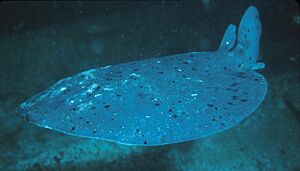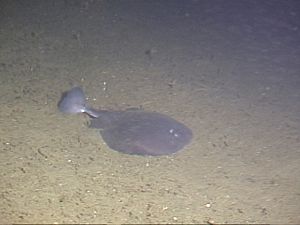Pacific electric ray facts for kids
Quick facts for kids Pacific electric ray |
|
|---|---|
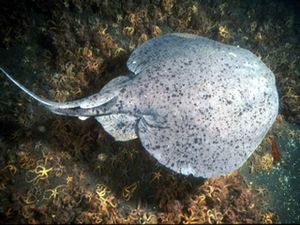 |
|
| Conservation status | |
| Scientific classification | |
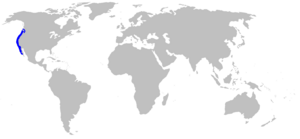 |
|
| Range of the Pacific electric ray | |
| Synonyms | |
|
Torpedo californica Ayres, 1855 |
The Tetronarce californica, also known as the Pacific electric ray, is a special type of electric ray. It lives only in the coastal waters of the northeastern Pacific Ocean. You can find it from Baja California all the way up to British Columbia.
This ray usually lives in sandy areas, rocky reefs, and kelp forests. It can be found from the surface down to about 200 meters (660 feet) deep. Sometimes, it even swims out into the open ocean. This ray can grow up to 1.4 meters (4.6 feet) long. It has smooth openings behind its eyes called spiracles, which help it breathe. Its back is dark gray, slate, or brown, and sometimes has dark spots.
The Pacific electric ray is a night owl, meaning it's active at night. It can create a powerful electric shock of up to 45 volts! It uses this shock to catch its food or to protect itself. It mostly eats bony fish. During the day, it hides and waits to ambush fish. At night, it actively hunts for them.
When baby rays are developing, they first get food from a yolk sac. Later, they get a special "uterine milk" from their mother. Females usually have 17 to 20 babies at a time, probably every two years. It's important to be careful around these rays. If they feel threatened, they can act aggressively. Their electric shock can even make a diver unable to move. Scientists also study these rays to learn more about the human body. The IUCN says this species is "Least Concern" because not many of them are caught by fishing.
Contents
About the Pacific Electric Ray
The Pacific electric ray was first described by an American fish scientist named William Orville Ayres. He was the first person to study fish at the California Academy of Sciences. Ayres named the ray after the U.S. state where it was first found by scientists in 1855.
Later, in 1861, another scientist named Theodore Gill put this ray into a new group called Tetronarce. He did this because of its smooth spiracles. Other scientists often think of Tetronarce as a smaller group within the Torpedo family. Rays that look very similar have been found off Peru, Chile, and Japan. They might even be the same species! Other common names for this ray include California torpedo ray or simply electric ray.
Where They Live
The Pacific electric ray is the only electric ray found off the western coast of North America. You can find it as far south as Sebastian Vizcaino Bay in Baja California. It lives as far north as the Dixon Entrance in northern British Columbia. It's most common south of Point Conception, California. The rays found north of this point might be a separate group.
Off California, these rays are usually found at depths of 3 to 30 meters (10 to 100 feet). Off Baja California, they are typically seen deeper, from 100 to 200 meters (330 to 660 feet). Some have even been reported as deep as 425 meters (1,394 feet). These rays prefer water temperatures between 10 and 13 degrees Celsius (50 to 55 degrees Fahrenheit).
They like sandy areas, rocky reefs, and kelp forests. However, one ray was seen swimming 17 kilometers (11 miles) west of Point Pinos, California. It was 10 meters (33 feet) below the surface in water 3 kilometers (1.9 miles) deep. This shows that these rays sometimes leave shallow coastal areas and swim into the epipelagic zone, which is the top layer of the open ocean.
What They Look Like
The Pacific electric ray has a soft, floppy body. It doesn't have any scales like many other fish. Its body is shaped like an oval disc, which is about 1.2 times wider than it is long. It has two kidney-shaped electric organs that you can see under its skin.
Its eyes are small, and behind them are smooth-rimmed spiracles. These are openings that help the ray breathe. There's a flap of skin between its nostrils that almost reaches its mouth. The mouth is curved with deep lines at the corners. This ray has many tiny, smooth teeth. There are 25 to 28 rows of teeth on the top and 19 to 26 rows on the bottom.
Pacific electric rays can be found in many places. These include Japan, the South Kuril Islands, and the Kinmei Seamount. They also live from Wiah Point, British Columbia, down to Todos Santos, Baja California. This includes Isla Guadalupe and Peru. They are common from San Francisco Bay southward. These rays can grow to be over 140 cm (55 inches) long. They are about 18–23 cm (7.1-9.1 inches) long when they are born. They can swim from the shallow surf zone down to 1,079 meters (3,539 feet) deep. However, they usually stay shallower than 300 meters (984 feet).
They have two dorsal fins on their back. The first dorsal fin is more than twice the size of the second one. It's located across from their large pelvic fins. Their tail is short and thick. It ends in a big, triangle-shaped caudal fin. The ray's top side is dark gray, slate, or brown. Sometimes it has small, darker spots that become more numerous as the ray gets older. Its underside is white. Male rays can grow up to 0.9 meters (3.0 feet) long. Females can reach 1.4 meters (4.6 feet) long. The heaviest one ever recorded weighed 41 kilograms (90 pounds).
Life in the Ocean
The Pacific electric ray has a large, oily liver and light body tissues. This helps it float easily in the water. It can stay in one spot without much effort. Its strong tail helps it move through the water. The disc-shaped body stays stiff. Studies show that these rays mostly swim at night. They go into reefs and other bumpy areas. During the day, they spend most of their time buried in the sand in open areas. They are usually alone, but sometimes several rays might rest in the same spot.
Like other electric rays, the Pacific electric ray can create strong electric shocks. They use these shocks to attack prey and defend themselves. Their two electric organs are made from muscle. These organs make up about 15% of the ray's total weight. They have thousands of jelly-filled "electric plates" stacked up high. These stacks work like batteries connected together. A large adult ray can create about 45 volts of electricity. This is powerful enough to deliver one kilowatt of power.
The electric organs send out quick pulses of electricity. Each pulse lasts about 4–5 milliseconds. When attacking food, the ray usually sends out 150–200 pulses per second at first. The pulses slow down over time. It might send out over a thousand pulses until its prey is stunned. The warmer the water, the faster the pulses.
Because of its large size and strong defenses, the Pacific electric ray is rarely eaten by other animals. There is one record of a killer whale eating one off Santa Catalina Island. The Cooper's nutmeg snail is a special parasite of this ray. It might also parasitize other bottom-dwelling fish like the Pacific angelshark. The snail is attracted to chemicals in the ray's mucus. It makes a small cut on the ray's belly and sucks blood with its proboscis. Other known parasites include a copepod called Trebius latifurcatus, a fluke called Amphibdelloides maccallumi, and a tapeworm called Acanthobothrium hispidum.
What They Eat
The Pacific electric ray mainly eats bony fish. This includes anchovies, herring, hake, mackerel, croakers, rockfishes, surfperches, kelp bass, and flatfishes. If it gets the chance, it will also eat cephalopods and other invertebrates. Its jaws can stretch very wide. This allows it to swallow surprisingly large prey. One female ray, 1.2 meters (3.9 feet) long, was seen eating a silver salmon that was almost half her length!
During the day, the Pacific electric ray is an ambush predator. It hides and waits. When a fish comes near its head, the ray "jumps" forward. It folds its disc-shaped body around the fish while delivering strong shocks. Once the fish is stunned, the ray moves it to swallow it head-first. This whole process takes about two minutes.
At night, many fish that are active during the day become still near the bottom. The Pacific electric ray then changes its hunting style. It actively stalks fish by slowly swimming or drifting. When it gets within 5 cm (2.0 inches) of its prey, it lunges forward. Again, it wraps its disc around the prey and delivers shocks. To hold the fish better, the ray might kick its tail. This can make it roll or somersault. Finally, the stunned prey is moved to its mouth using ripples of the disc. In one case, a 75 cm (30 inch) female caught and ate a 20 cm (7.9 inch) jack mackerel in less than ten seconds. Sometimes, Pacific electric rays are caught in nets at the surface of Monterey Bay at night. This suggests they rise from the bottom to feed on small fish.
The Pacific electric ray will eat at any time. However, it reacts much faster to prey at night than during the day. Most prey is caught in darkness or cloudy water. In these conditions, its eyes are not very useful. Instead, it uses its electroreception (ability to sense electric fields) through its ampullae of Lorenzini to find food. Experiments show that it will attack fake electric fields and metal electrodes. Sensing movement with its lateral line is also important. This ray has been seen choosing to attack faster-moving prey, even if there was food closer by.
Life Cycle and Reproduction
The Pacific electric ray gives birth to live young. The developing babies first get food from a yolk sac. Later, they get a special "uterine milk" from the mother. This milk is rich in proteins, fat, and mucus. It is delivered through special growths in the mother's uterus. Adult females have two working ovaries and uteruses.
Reproduction happens all year round. Males seem to be able to mate every year. Females probably mate every other year. We don't know exactly how long the babies stay inside the mother. Females usually have 17 to 20 babies in a litter. The number of eggs, and perhaps the number of young, increases as the female gets bigger.
Newborn rays are about 18–23 cm (7.1-9.1 inches) long. They double their size in their first year, growing about 25 cm (9.8 inches) longer. Males grow faster than females but end up being smaller. Males become ready to reproduce at about 65 cm (26 inches) long and seven years old. Females are ready at about 73 cm (29 inches) long and nine years old. The oldest ray found was 16 years old. Scientists think they might live up to 24 years.
Interactions with Humans
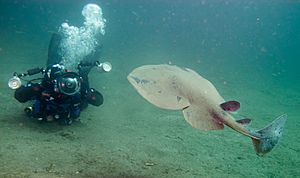
The electric shock from a Pacific electric ray can be strong enough to knock down an adult human. You should be careful around them, especially at night when they are active. They have been known to charge at divers with their mouths open if they feel bothered. No deaths have been directly linked to these rays. However, they might have been involved in some unexplained diving accidents.
These rays don't do well in aquariums at first. They often refuse to eat when they are put into a tank. But since 2000, the Aquarium of the Bay and the Monterey Bay Aquarium have had some success keeping them. They do this by offering the rays moving food.
The Pacific electric ray and its relatives are used by scientists for medical research. Their electric organs have many important nervous system proteins. These include the nicotinic acetylcholine receptor and acetylcholinesterase. In the 1970s and 1980s, these proteins from electric rays were the first to be studied in detail. This was a big step forward in understanding how our nerves work. It led to many other discoveries, like understanding the disease myasthenia gravis.
A small commercial fishery in southern California catches Pacific electric rays for research. As of 2005, only a couple of fishers might have been involved in this. Otherwise, this ray is not caught for money. It is sometimes caught by accident in commercial trawl and gillnet fisheries. It is also caught by sport anglers using hooks and lines. These activities don't seem to harm the ray's population much. That's why the IUCN lists it as "Least Concern". Fishing for this ray is not managed by the Pacific Fishery Management Council.



